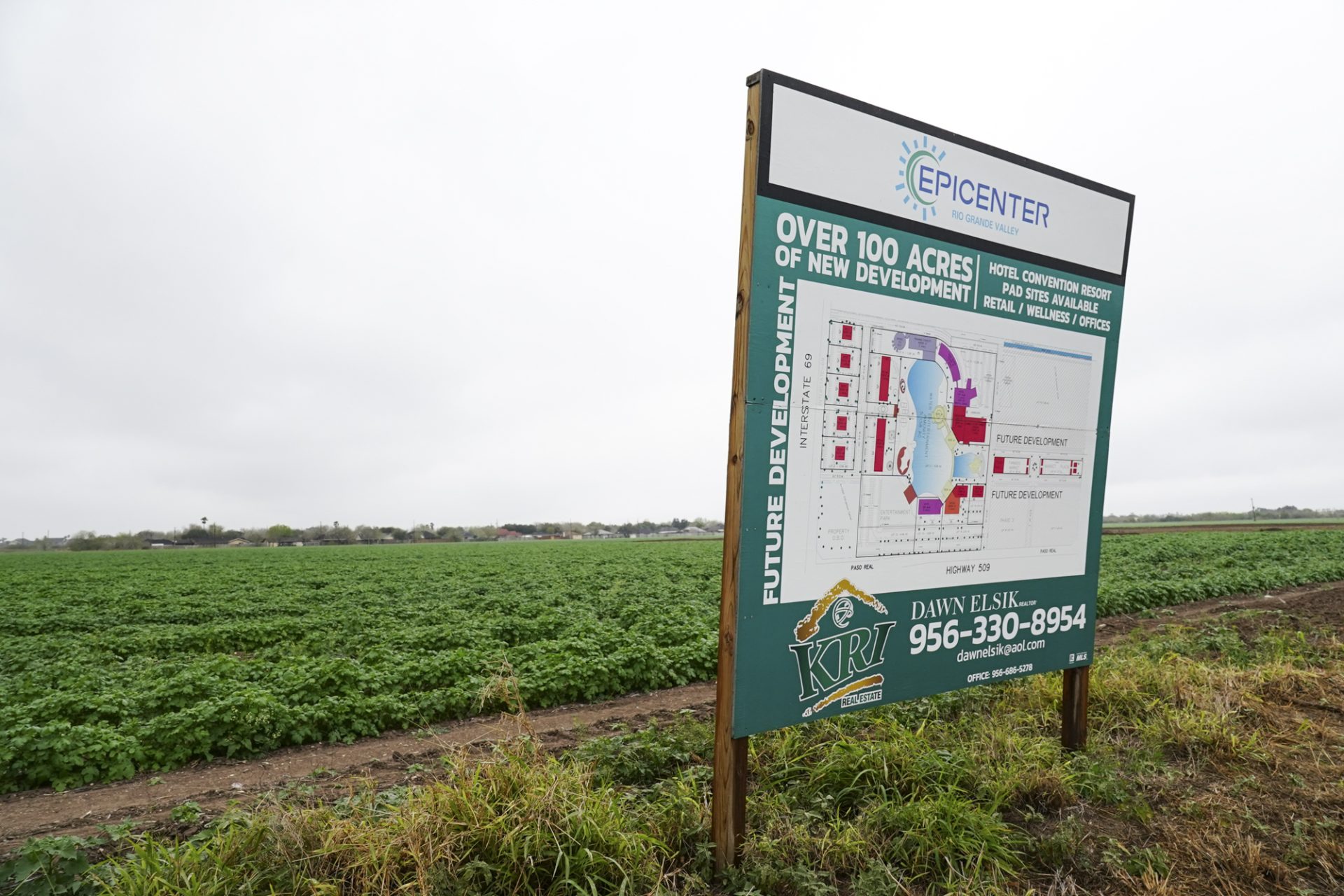|
Only have a minute? Listen instead
Getting your Trinity Audio player ready...
|

SAN BENITO — The future of one of the Rio Grande Valley’s biggest projects hangs in limbo.
About five years after the city’s past administration began making plans for a proposed $700 million, 115-acre entertainment mecca surrounding a hotel and convention center opening more than 1,000 jobs, the city’s new commission is cutting off the developer’s incentives two years after breaking ground on the stalled project.
Now, Western Spherical Developers’ owes the San Benito Economic Development Corporation a year’s worth of lease payments along with back taxes and late fees, Ramiro Aleman, the agency’s executive director, said.
From about August 2022 to July, the EDC paid a total of $32,513 in property taxes along with $2,127 in penalties while the developer wasn’t paying on a monthly $1,000 lease on an agency-owned building at 2550 E. Expressway 83, he said.
Two years after calling on commissioners to create a tax increment reinvestment zone along the 115-acre proposed project site near FM 509 and Shafer Road, developer David Miles was requesting they extend the zone’s agreement from 2022 to 2026, Commissioner Pete Galvan said.
Tax increment reinvestment zones are public financing tools used to help fund economic development projects in which properties’ assessed values are frozen based on the theory those values will increase. The increased property taxes collected would make up the increment.
After weeks of consideration, the new commission’s majority rejected the request.
“We just decided enough is enough,” Mayor Rick Guerra said in an interview. “He was requesting more from the city. We said, ‘Well, you haven’t done anything in all these years.’ We like (the project), people like it, but he hasn’t done anything. The city can’t just stay stagnant there.”
Meanwhile, the developer’s TIRZ agreement continues through 2036, Linda Merritt, the developer’s representative, stated, noting a 15-year term.
“It was a surprise that the San Benito city commissioners chose to vote against any further incentives for the RGV Epicenter development agreement,” she stated. “TIRZ incentives were approved for the … property in 2021 and remain vested for the property until 2036. TIRZ incentives include land improvement infrastructure for the RGV Epicenter development.”
Now, the developer is considering other partners, Merritt stated.
“Western Spherical Developers is currently considering options moving forward including best use of the property,” she stated. “The development team remains committed to the vision of RGV Epicenter and looks forward to working with the RGV Region for a positive economic development impact for the RGV region.”
In October 2021, the developer and past administration broke ground on the project.
Since the project stalled, Miles has cited the coronavirus pandemic’s supply chain crisis’ escalations of material costs as a factor behind the delays.
Since Miles presented the project to then-City Manager Manuel De La Rosa and the city’s past commission in 2017, the developer has failed to move forward with development, Galvan said.
“The project has been in discussion since 2017,” he said. “We needed to see faster movement. In my opinion, I think we need to focus our priorities on the town, which are infrastructure and streets.”
Galvan said a League City official’s information regarding a similar project in the Galveston Bay area helped him come to his decision.
“That solidified my suspicions,” he said.
In 2018, Western Spherical Developers proposed a similar project in League City, Galvan said.
But the project didn’t get off the ground, he said.

For months, Galvan’s raised questions surrounding city expenses incurred since Miles presented the project to the city’s past administration.
In 2019, the city requested its former lobbyist work to help former State Sen. Eddie Lucio Jr. and former State Rep. Eddie Lucio III pass House Bills 4347 and 2199, which allow cities to spend hotel occupancy tax revenue generated through developments to fund construction of convention centers and sports and entertainment projects.
The two bills would help Miles fund costs through hotel occupancy tax revenue.
Galvan also pointed to De La Rosa’s and former City Attorney Mark Sossi’s time spent on reviewing the project’s documents.
Like Galvan, Commissioner Deborah Morales said she wants to focus on city operations.
“Me personally, I didn’t see it as a viable project,” she said. “I thought it lingered on too long. I didn’t see that it was going to work. We need to follow the objectives at hand, what the community wants — infrastructure and streets.”
Meanwhile, Commissioner Tom Goodman said he continued to stand behind the project.
“I would have liked to see us move forward but the majority didn’t want to,” he said. “In my opinion, if we got behind it as a community we could make it work. Looking at a larger picture of what’s going on in the Valley, this was to be a regional project. All of the Valley’s growth indicates such a development can happen.”
What would have become the city’s biggest economic development project would have created 1,013 jobs along with an additional 1,077 jobs during a three-year construction period, according to Miles’ presentations before commissioners.
As part of the project, Miles proposed the development of a sprawling “village” featuring two hotels, an entertainment center, a sports complex, restaurants and retail shops along with a five-acre “Crystal Lagoon.”
More than five years ago, Tammy Huerta, daughter of the late Grammy-award winning singer Freddy Fender, helped spark talks with De La Rosa, Miles told commissioners.




